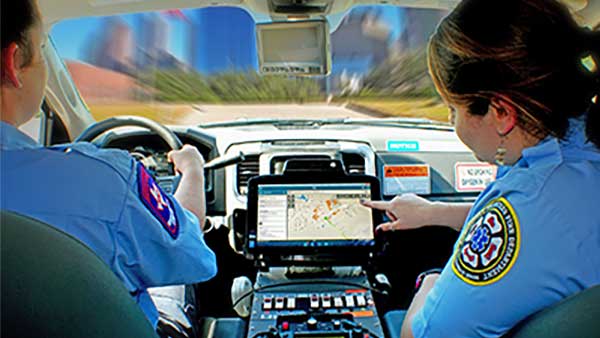
Coordination is Key to Mobilizing First Responders in an Emergency. So, Should Public Sector Agencies Sync Up Their Mobility Strategies?
Last week, I emphasized just how critical it is that first and second responders have reliable communications technology in hand, whether responding to an emergency or everyday service call. The amount of coordination required between responders – whether evacuating an entire island ahead of a storm or trying to restore peace, order and power after a disaster – warrants investment in quality communications systems.
“Can you hear me now?” is a question that you should never hear a first – or even, second – responder ask anyone ever. Especially not in the middle of an emergency response or in the wake of a natural disaster.
That is why it is your responsibility – as the agency lead, police or fire chief, IT director, field technician supervisor or perhaps procurement official – to ensure that every “responder” you dispatch to a call will have a mobile computer – whether a tablet or handheld – that will work no matter what. It is also your job to ensure your organization can stay in sync with other responding agencies, whether via voice comms or back-end data systems.
Not an easy feat, I admit. However, today’s mobile tools are better than ever.
Since public sector organizations don’t compete with one another, you can engage in, and greatly benefit from, collaborative procurement. Often, I’ll see a fire department and city planners follow the lead of the police department. Or building inspectors use the same rugged tablets as the public works team. We also see neighboring jurisdictions coordinate their communications solutions so they can ensure continuity of communications in multi-agency response scenarios. It’s not uncommon for public and private sector entities to jointly plan and execute infrastructure enhancements or emergency response initiatives.
Here along the Jersey Shore, public safety officials drove most of the communication and utility-related upgrades after Hurricane Sandy based on lessons learned and forward thinking to mitigate problems. With power grid reclosers, there will be less “live” wires down, fewer homes affected and increased odds that the power will stay on for many. With natural gas VLPs installed, the risk of fire is reduced even more, while allowing gas service to be restarted sooner. And local public safety departments can now access these upgraded public safety networks with “priority and pre-emption” status every day of the year – for regular police, fire and EMS response, and when tackling other natural disasters like nor’easters – assuming they are using rugged tablets or handheld mobile computers that have been certified to work with such networks. (You can read more about those certifications in this blog.)
Looking across the U.S., the simultaneous adoption of the rugged tablet-based Battalion 3 Technologies (BATT3) digital Incident Command (ICx) and Fire Roster solution by three fire departments in Idaho is another prime example of how coordinated communications procurements can pay off.
The Northern Lakes Fire District, Coeur d’Alene Fire Department, and Kootenai County Fire and Rescue are using this industry-first digital solution to improve coordination of on-scene resources and increase first responder accountability and incident reporting. The software running exclusively on these Zebra R12 rugged tablets has allowed the agencies – which are often called for joint response scenarios – to increase the accuracy of their emergency response tracking, reduce safety risks and streamline command and control processes.
###
Editor’s Note:
If you haven’t heard of this Batt3 solution and you’re responsible for buying mobility solutions for fire and rescue or law enforcement officials, you’ll want to read this:
Northern Lakes Fire District Maintains 100% Accountability, Improves Firefighter Safety on Scene
###
A Final Tip: Rethink the “Basic Necessities” of Your Emergency Communications Toolkit
The amount of planning, coordination and communication performed by our public safety sector is impressive. It is also never-ending – learning from the past, absorbing new techniques and tools and pushing the private sector to innovate. Dedicated public safety networks and rugged mobile devices that are certified to work on those networks – and built to last in emergency situations – are certainly essential to any critical communications strategy. But so are mobile printers and drones, which are among the top technologies on the forefront of innovation in both the public and private sector.
As I mentioned in my last blog, drones can address public safety’s unique communications and coordination needs as flying cell “towers”, to conduct reconnaissance and to stream video for enhanced situational awareness and response planning. Drones can also support utilities’ unique needs as second responders by aiding with pipeline and transmission line inspections, forest fire mapping and more.
And I’ve been fortunate enough to have a front seat to some of this innovation.
The geography of Cape May County makes it both a great vacation spot and an advantageous locale for research and development (R&D).
There’s a new development facility for Unmanned Aerial Vehicles (UAVs or “drones”) at the southern tip of the peninsula. Surrounded on three sides by water, it is a great place to safely test aircraft. During World War II (WWII), Naval Air Station Wildwood was used to train aviators on the planes that were on the forefront of the Navy’s campaigns, such as the Grumman Wildcat and Hellcat, the SBD Douglas Dauntless and the F4U Corsair. As young pilots were learning to fly these difficult machines, if something went wrong, they could bailout over water, minimizing the risk to the civilian population below.
Now the air station and surrounding area has been repurposed for UAV development. Those same runways used by naval aviators during WWII are now used for large UAV aircraft. The same peninsula, with over 400 species of migrating birds, is navigated by these new UAVs. And in the rare instance of failure, the Atlantic Ocean or Delaware Bay surround the air station, minimizing the risk to anyone on the ground.
These efforts benefit from their proximity to the real-world public safety and utility experts who plan for and respond to all kinds of emergencies, from summer hurricanes, to fall nor’easters and winter blizzards – such as the OC Police Department detective that led the development of Ocean City’s emergency plan.
More importantly, the communications and coordination that occur between the public and private sectors – from the technology planning to procurement to testing and ultimate implementation phases – benefit us all. The concerted and ongoing efforts behind the scenes, far in advance of any emergency, reduce the risk of chaos and protect lives. And the communication technology decisions made today ensure that your hometown’s emergency response strategy can be executed according to plan if a situation were to arise tomorrow.
So, the challenge for public safety and utility organizations – as first and second responders – is to review your emergency response plan with a focus on your communications strategy. Do you have the right technologies on hand to make sure that you can maintain communications with your response teams and partner agencies? Or is there a chance that communications could breakdown if wireless networks go down? Are your mobile devices as resilient as the people running toward the storm – or fire or earthquake?
What do you need to engineer a communications plan that will “just work” as it’s supposed to? A rugged mobile computer engineered to connect to wireless networks via “priority and pre-emption” status when service goes down for others? Rugged tablets running the digital Incident Command software needed to facilitate multi-agency responses? A drone that can capture video footage overhead to offer real-time guidance to mobile device-equipped responders on the ground?
Take the time now to assess your needs and acquire those technology tools that will ensure your emergency response plan and/or your services “just work” as they should every day – even if an emergency situation were to arise.
###
Editor's Note:
Learn more about how Zebra’s rugged mobility, printing and IoT technologies can help facilitate critical (and reliable) communications during emergency situations and during everyday public safety events at IACP 2019. Visit booth #3855 to see our full range of public safety solutions, including a wide range of rugged tablets and handheld mobile computers that are certified to work on both of the dedicated public safety networks in the U.S.
You can also learn why rugged mobile computers are best for public safety, and what makes a device truly rugged, by catching up on these blogs:
- Not All “Mobile” Computers are Mobile – and Not All Rugged Tablets are the Same
- Survey Says: Police Officers Need Mobile Technology That’s Actually Mobile
- PSA: Just Because a Mobile Device Is Certified for “Priority and Pre-Emption” on a Dedicated Public Safety Network Doesn’t Mean It Is Suitable for Public Safety Use
- 5 Ways to Tell if Your "Rugged" Tablet, Laptop or Handheld is a Knockoff

Bob Ashenbrenner
Durable Mobility Technologies, LLC, under the direction of Bob Ashenbrenner, works with Zebra Technologies to develop future-proof mobility solutions for customers across multiple field service and industrial sectors. As an industry consultant, Durable Mobility Technologies, LLC, is focused on optimizing rugged tablet-based solutions for mobile workers of all kinds, including utility and public safety professionals. Ashenbrenner is particularly committed to helping customers identify mobile devices that survive a tough work day, run all the software and tools needed today, and will remain flexible and scalable to adapt to evolving technology applications as business needs dictate.
Ashenbrenner has more than 25 years of computer engineering and engineering management experience, with 18 of those specific to mobility and the field requirements that enable real work to happen. He was previously a Solutions Architect with Xplore Technologies and Motion Computing for 13 years. In that role, Ashenbrenner led the development of a suite of rugged mobile tablet computer, services and software, with an emphasis on supporting the whole mobile work environment.






